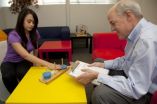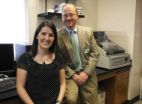Scientists show how social interaction and teamwork lead to human intelligence
Scientists have discovered proof that the evolution of intelligence and larger brain sizes can be driven by cooperation
2012-04-21
(Press-News.org) Scientists have discovered proof that the evolution of intelligence and larger brain sizes can be driven by cooperation and teamwork, shedding new light on the origins of what it means to be human. The study appears online in the journal Proceedings of the Royal Society B and was led by scientists at Trinity College Dublin: PhD student, Luke McNally and Assistant Professor Dr Andrew Jackson at the School of Natural Sciences in collaboration with Dr Sam Brown of the University of Edinburgh.
The researchers constructed computer models of artificial organisms, endowed with artificial brains, which played each other in classic games, such as the 'Prisoner's Dilemma', that encapsulate human social interaction. They used 50 simple brains, each with up to 10 internal processing and 10 associated memory nodes.
The brains were pitted against each other in these classic games. The game was treated as a competition, and just as real life favours successful individuals, so the best of these digital organisms which was defined as how high they scored in the games, less a penalty for the size of their brains were allowed to reproduce and populate the next generation of organisms.
By allowing the brains of these digital organisms to evolve freely in their model the researchers were able to show that the transition to cooperative society leads to the strongest selection for bigger brains. Bigger brains essentially did better as cooperation increased.
The social strategies that emerge spontaneously in these bigger, more intelligent brains show complex memory and decision making. Behaviours like forgiveness, patience, deceit and Machiavellian trickery all evolve within the game as individuals try to adapt to their social environment.
"The strongest selection for larger, more intelligent brains, occurred when the social groups were first beginning to start cooperating, which then kicked off an evolutionary Machiavellian arms race of one individual trying to outsmart the other by investing in a larger brain. Our digital organisms typically start to evolve more complex 'brains' when their societies first begin to develop cooperation." explained Dr Andrew Jackson.
The idea that social interactions underlie the evolution of intelligence has been around since the mid-70s, but support for this hypothesis has come largely from correlative studies where large brains were observed in more social animals. The authors of the current research provide the first evidence that mechanistically links decision making in social interactions with the evolution of intelligence.
This study highlights the utility of evolutionary models of artificial intelligence in answering fundamental biological questions about our own origins.
"Our model differs in that we exploit the use of theoretical experimental evolution combined with artificial neural networks to actually prove that yes, there is an actual cause-and-effect link between needing a large brain to compete against and cooperate with your social group mates."
"Our extraordinary level of intelligence defines mankind and sets us apart from the rest of the animal kingdom. It has given us the arts, science and language, and above all else the ability to question our very existence and ponder the origins of what makes us unique both as individuals and as a species," concluded PhD student and lead author Luke McNally.
INFORMATION:
Luke McNally, lead author +353-(0)857137001/ mcnalll@tcd.ie
Dr Andrew Jackson is available for interview, contact +353-(0)86-8054529/ Andrew.jackson@tcd.ie
For additional media queries contact: TCD Press Officer, Caoimhe Ní Lochlainn, tel: +353-1-8962310
END
ELSE PRESS RELEASES FROM THIS DATE:
2012-04-21
CINCINNATI—Cardiac researchers at the University of Cincinnati (UC) have found that a certain cellular pathway is linked to obesity-related disorders, like diabetes, heart disease and fatty liver disease.
These findings, being presented at the American Heart Association's Arteriosclerosis, Thrombosis and Vascular Biology (ATVB) 2012 Scientific Sessions in Chicago, April 19, 2012, could lead to a potential molecular target for metabolic diseases in humans.
Building on previous research, Tapan Chatterjee, PhD, and researchers in the division of cardiovascular diseases ...
2012-04-21
(CHICAGO) – In the 19th century, Jean-Martin Charcot, the celebrated neurologist, developed a "vibration chair," to relieve symptoms of Parkinson's disease. Charcot reported improvements in his patients, but he died shortly thereafter and a more complete evaluation of the therapy was never conducted. Now, a group of neurological researchers at Rush University Medical Center have replicated his work in a study to see if Charcot's observation holds true against modern scientific testing.
Results from the study indicate that while vibration therapy does significantly improve ...
2012-04-21
CAMBRIDGE, Mass. -- In a study appearing this month in the journal Environmental Science and Technology, MIT researchers report that emissions from cars, trucks, planes and powerplants cause 13,000 premature deaths in the United Kingdom each year.
The researchers analyzed data from 2005, the most recent year for which information is available. They found that among the various sources of emissions in the country, car and truck exhaust was the single greatest contributor to premature death, affecting some 3,300 people per year. By comparison, the researchers note, fewer ...
2012-04-21
The National Institutes of Health (NIH) has awarded a five-year, $9 million grant to the University of Houston's Texas Center for Learning Disabilities to conduct research on the causes and treatment of learning disabilities in children and adolescents. UH is one of four universities nationally to receive funding from the NIH for a learning disability research center.
The substantial number of today's adolescents struggling with weak literacy skills presents an urgent national concern, yet little is known about reading disabilities beyond the early elementary grades. ...
2012-04-21
MyBinding.com, one of the country's leading retailers of document finishing machines and supplies, is partnering with Boom Fitness to provide their employees with a fitness program.
"The health of our employees is very important to us," said Jeff McRitchie, Vice President of Marketing for MyBinding.com. "Many of our employees sit for most of the day and we wanted a way to help our staff stay active."
McRitchie joined Boom Fitness for personal reasons and brought several employees along with him. As more employees joined, the two companies decided ...
2012-04-21
Stressed out lizard moms tend to give their developing embryos short shrift, but the hardship may ultimately be a good thing for the babies once they're born, according to a study published in the journal Physiological and Biochemical Zoology.
Stress changes the way animals allocate energy. During predator attacks or food shortages, hormones are released that help the body to access stored energy. But for pregnant females there's a potential trade-off. Stress hormones could rob precious energy from developing embryos, leading to offspring that aren't as healthy.
A research ...
2012-04-21
The need to swab the noses of pregnant women and newborns for the presence of MRSA (methicillin-resistant Staphylococcus aureus) may be unfounded, according to a Vanderbilt study now available online and published in the May issue of Pediatrics.
The study's senior author, Buddy Creech, M.D., MPH, assistant professor of Pediatrics, said it is often feared that mothers carrying MRSA may risk transmitting an infection to their newborn babies, but Vanderbilt Pediatric Infectious Diseases researchers found that babies rarely became ill from MRSA infections, despite frequently ...
2012-04-21
WasThatGood recently announced the launch of a new website meant to offer the public an arena to voice their opinions of the London theatre. The site is designed to fill a gap in a niche where misreporting and sycophancy abound and, as such, offers theatre-goers not only a fair assessment of various productions by their peers but also a venue to air their own opinions without censure.
In the age of information, it is surprising that people who enjoy the London stage and all it has to offer have little choice when it comes to finding honest and transparent reviews on ...
2012-04-21
Philadelphia– While most teens do buckle up when driving, new research shows that novice teen drivers who live in states with so-called "secondary enforcement" seat belt laws are less likely to use the life-saving devices than those in "primary enforcement" states. The research, conducted by The Children's Hospital of Philadelphia (CHOP) and State Farm®, is published in the American Journal of Public Health. The research found seat belt use rates differed as teens moved through the probationary licensing process known as Graduated Driver Licensing (GDL).
A primary seat ...
2012-04-21
Imagine owning a television with the thickness and weight of a sheet of paper. It will be possible, someday, thanks to the growing industry of printed electronics. The process, which allows manufacturers to literally print or roll materials onto surfaces to produce an electronically functional device, is already used in organic solar cells and organic light-emitting diodes (OLEDs) that form the displays of cellphones.
Although this emerging technology is expected to grow by tens of billions of dollars over the next 10 years, one challenge is in manufacturing at low cost ...
LAST 30 PRESS RELEASES:
[Press-News.org] Scientists show how social interaction and teamwork lead to human intelligence
Scientists have discovered proof that the evolution of intelligence and larger brain sizes can be driven by cooperation




